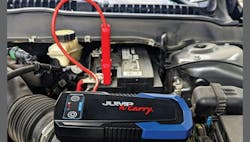Lithium jump starters — safe, smart, and effective usage tips
We get many emails and phone calls related to the use of lithium jump starters. The specific topics of interest vary, but they typically fall within a handful of areas related to effectiveness and safe use. Here are a few examples: What do I need to know? Where can I use them? How do I take care of them? How do I keep them safe?
We’ve all seen news stories related to lithium battery safety issues, which drive many of these questions from our customers. Prospective buyers are concerned to be sure they understand the best ways to use these products to keep themselves and their property safe. So, this month, we thought we’d break this topic down to help prospective customers better understand these products and the best practices to employ them to overcome dead batteries in the safest manner possible.
The more things change, the more safety basics stay the same
Even though your lithium jump starter is quite different as compared to your JNC660, the fundamentals of the jump starting application are largely unchanged, so that means all of the basic building blocks of jump starting safety remain the same:
- Always wear protective eyewear
- Always make sure your voltages match (vehicle and jump starter)
- Always remove jewelry, such as rings, when working around a battery
- Never run the risk of dropping a tool across a battery's terminals
- Always follow the proper connection procedure
- Always make your negative connection to a proper ground (away from the battery)
Following these simple steps, no matter the type of jumpstarter you are using, will increase your safety factor exponentially. A vehicle battery, especially a compromised one, can be dangerous. Taking a safety-first approach just makes sense when working around them.
Starting with equipment in good working order
Ensuring that your equipment is in good working condition is always a good idea. It is particularly important when it comes to lithium jump starters. For these products, there’s three key things to keep in mind: 1.) the unit has a good state of charge, 2.) the electronics are working properly, and 3.) the output cables and clamps are not compromised.
We harp on this, but it’s really important to keep your jump starter properly charged for several reasons. First, it is most effective when it’s fully charged. We recommend that a lithium jump starter be at or above 75 percent State of Charge (SoC) when it is used for jump starting purposes. This will massively improve your chances of getting a good jump start on the disabled vehicle. It also reduces the stress on the jump starter itself since you are not exposing the unit to a high-stress event (jump starting) when it’s at its weakest. Following the 75 percent plus rule will result in a longer unit life. So, when it gets below 75 percent or you have had to use the unit for a tough jump start, charge it up. If it’s been sitting unused for a few months, charge it up every 90 days or so. We even provide free quarterly recharge alerts to help remind you to keep your unit well-charged.
Always check your lithium jump starter chassis, interface, and buttons before use and before charging. Has it received a sharp blow? Is the case compromised as a result of a damaging drop? Has the user interface degraded to the point where the buttons are only working some of the time? Do the electronics and safeties only seem to work some of the time, or do you get weird behavior from the unit occasionally? If any of these conditions exist, you may need to take your unit out of service. The reason these units can be so small and still start a vehicle is that the battery that drives them is very energy-dense. That’s great when it’s time to start a vehicle, but it can be problematic if the battery is compromised in any way. Just as you shouldn’t operate a laptop with a damaged battery, you also shouldn’t operate a lithium jump starter that you have reason to believe is damaged.
Each time you use your jump starter to start a disabled vehicle, it is wise to check the power path components (connectors, cables, clamps) to ensure that they are in good condition prior to use. Make sure that the cable jackets are intact, the clamps are not damaged, and that all connections (if the cables aren’t fixed) are properly seated and secure. This is very important. For instance, if an output cable had a frayed cable jacket and the cable itself was exposed, any contact with a vehicle's metal surface could cause a short, which is bad for vehicle electronics and could be damaging for the jump starter itself.
Safety circuits are critical in this class of jump starter
As noted above, the batteries found in lithium jump starters are extremely energy dense, which is why you can start a car using a battery the size of a deck of cards. The downside of this energy density is that the battery must be protected against unsafe conditions. This is true for any product containing a lithium battery, but is especially critical in a product that subjects the battery to an inherently stressful application like jump starting. So, the quality of the safety circuitry is a huge determinant of the overall safety of the unit itself.
From our point of view, this need for safe circuitry to protect the battery from dangerous conditions is most easily addressed by ensuring that any unit you consider for purchase is certified to meet the requirements of UL2743, which is the prevailing safety standard for this class of product in North America. Meeting UL2743 doesn’t necessarily mean a specific product will perform well, but it does mean that it delivers the safety required by the standard. Any product that meets this standard will be marked as such. For instance, our Jump-N-Carry lithium jump starters call out the fact that they are certified to conform to the requirements of UL2743 on both the display carton and the rear silkscreen of each model. We would counsel our family and friends not to purchase a unit that doesn’t meet this standard.
Separately, we would also advise our family and friends that the gold standard for safety for these units is for all safety circuitry to be located within the body of the unit itself. Several years ago, it was common for units to have safety circuitry on the output cable(s). In 2025, this really is an outdated practice, and units that still follow this methodology should be avoided since we would say that they are inherently less safe than units with the protection inside the unit itself. This brings up an important point. If you ever damage the output cables/clamps of your lithium jump starter, you should do everything possible to replace them with an exact OE replacement from the manufacturer, especially if you do have a unit with the safety on the cable.
Finally, when it comes to safety circuitry, a quality unit will take into account the fact that these units are more sensitive to temperature than traditional jump starters. For instance, they should never be charged if the battery’s temperature is below 32 degrees F. Jump-N-Carry lithium jump starters feature temperature monitoring and will not allow charging energy to reach the battery unit if the battery is above 32 degrees F.
Things to remember when jump starting
Like the general safety tips at the start of this article, most aspects of the jump-starting application are the same whether you are using a lead acid jump starter or a lithium jump starter. Of course, make sure you understand the vehicle battery’s polarity and align it. If the vehicle’s battery is totally dead and the jump starter can’t recognize a proper connection, many units have a workaround for that. For instance, our Jump-N-Carry lithium jump starters feature an override button that can force the unit to engage with a totally dead battery. Whenever you use a workaround like this, it is important to double-check your connections before pressing the override button. While our units do have safeties in place even when the override feature is deployed, a simple extra check that an error wasn’t made during the initial connection process is a best practice that should be followed every time.
The other key thing to remember is that your jump starter has a duty cycle. In our case, our units have a 6-second on (cranking the engine) followed by a 180-second rest period. Our safety circuit enforces this duty cycle, but not all units have this protection. So, it is important that you understand the prescribed duty cycle of any unit you own/use to avoid overtaxing the unit, which can stress the battery to the point of failure and can be a real problem for some lithium jump starters. Again, this is not the case with our units. Jump-N-Carry lithium jump starters feature overcrank protection, which essentially enforces the prescribed duty cycle.
Storage and transport: Best practices
The first thing to remember for safe transport and storage of your lithium unit is to disconnect your cable/clamps from the unit (if the unit has detachable cables) once you have finished your jump-starting task. We’d also recommend covering all ports that have covers, as our JNC units do. In addition, it is a best practice to return the unit to its case/pouch/bag for secure storage and transport. While you’re at it, check the clamps for battery acid or other vehicle greases/fluids and wipe them clean (in a safe manner) prior to storage.
As noted above, these units are sensitive to extreme temperatures. If you plan to store your unit in your vehicle during the hottest part of the summer, we recommend keeping it in an area where it can get some circulation and that avoids extreme heat build-up. For instance, we do not recommend storing a unit in the glove box. Studies have shown that the glove box can be 10 to 15 degrees F hotter than the space under a seat on the hottest days. During winter, storing your jump starter in your vehicle shouldn’t be a problem. Check the temperature rating of your unit and make sure that overnight temps won’t dip below the recommended operating range of your specific unit. If they are expected to do so, we recommend bringing the unit inside for the night until milder weather returns. Also, if you are experiencing extreme cold, you may want to charge your unit more regularly (once the unit has warmed up) to ensure the unit has a good, full charge and will be ready when you need it the most.
Jump-N-Carry power with advanced safety features
Our lineup of Jump-N-Carry lithium jump starters delivers an optimal combination of power, smarts, and safety to the jump starting application for professional technicians and vehicle owners. With three models from which to choose, it’s easy to find the one that matches your specific needs, from our 1000A (300 Start Assist Amps) JNC305 to our 3000A (550 Start Assist Amps) JNC345. All models feature long cable lengths for easy access to vehicle starting points, an override feature that allows them to engage a totally dead (0.0V) battery and detachable cables for safe, secure storage.
One great way to gauge the usefulness and power of a jump starter is to look at how effective it is when operating in cold temperatures. This is an area where Jump-N-Carry has always outperformed, and these models are no exception. We rate our JNC305 model as effective to 0 degrees F, our JNC325 model as effective to -10 degrees F, and our JNC345 model as effective to -23 degrees F. They are built tough and designed to deliver the goods in the real world, where cold weather is often the culprit behind an underperforming vehicle battery.
All Jump-N-Carry lithium jump starter models conform to and are lab-certified to meet the requirements of the UL2743 safety certification, the prevailing safety standard for this class of product. In fact, our units far exceed these requirements, bringing advanced safety features to our units that protect the operator and the equipment under service during the jump starting event. Jump starting, frankly, is a harsh application that can put great stress on the jump starter and its battery during particularly difficult starts. Our models are specifically designed to withstand these difficult starting situations, just like our lead acid models have been doing for 30 plus years.



